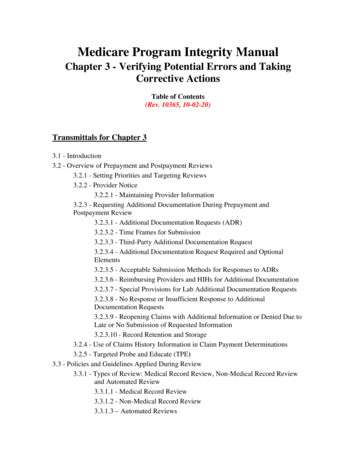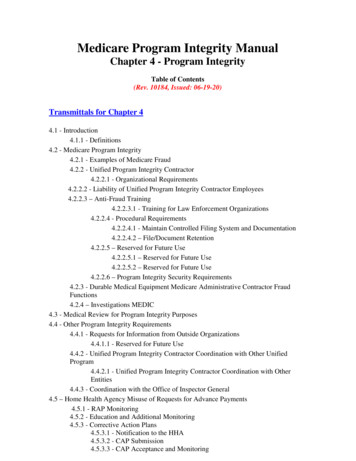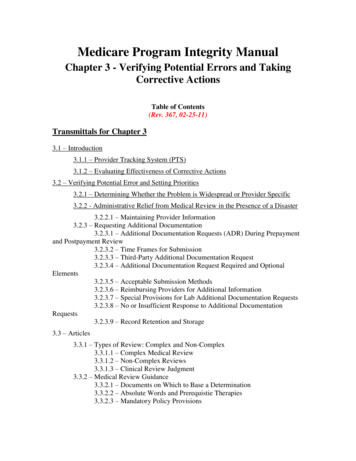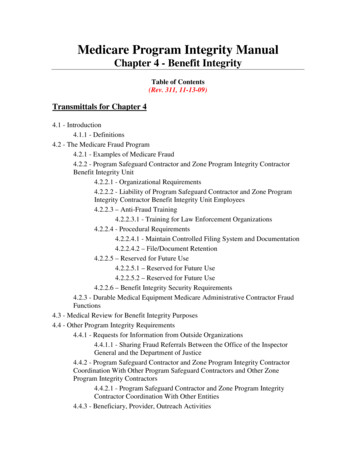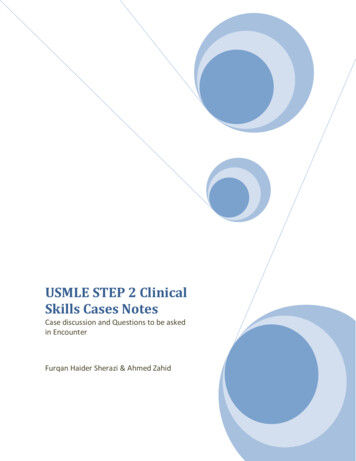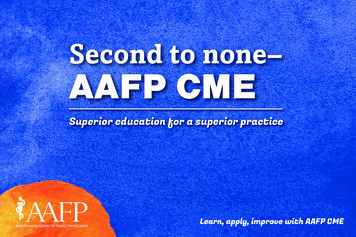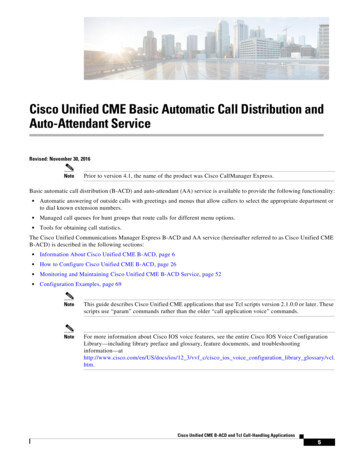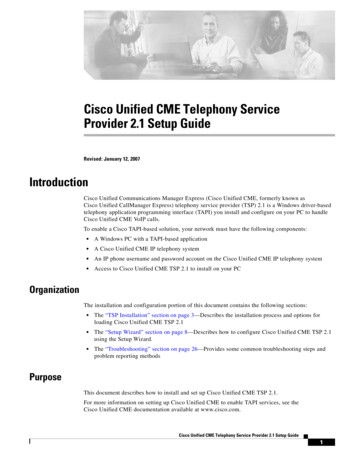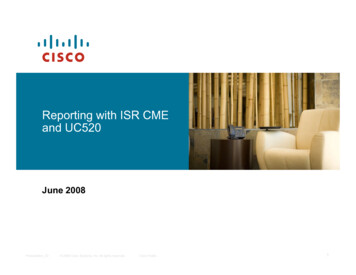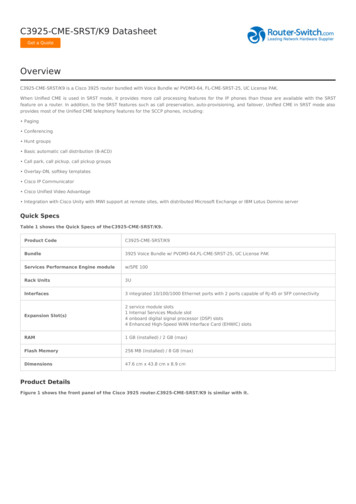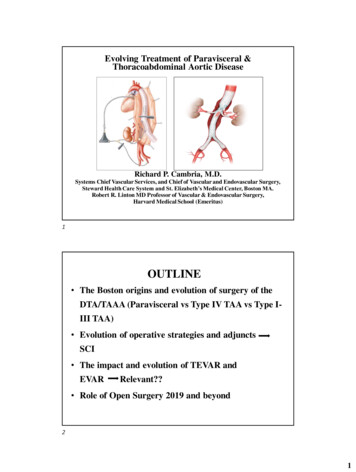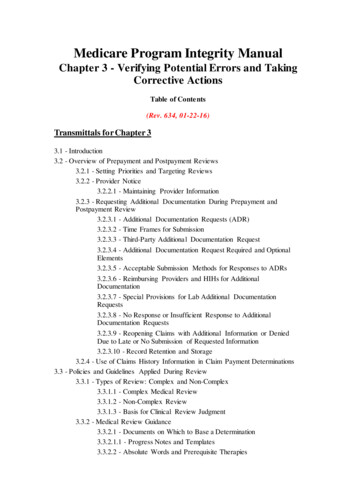
Transcription
Medicare Program Integrity ManualChapter 3 - Verifying Potential Errors and TakingCorrective ActionsTable of Contents(Rev. 634, 01-22-16)Transmittals for Chapter 33.1 - Introduction3.2 - Overview of Prepayment and Postpayment Reviews3.2.1 - Setting Priorities and Targeting Reviews3.2.2 - Provider Notice3.2.2.1 - Maintaining Provider Information3.2.3 - Requesting Additional Documentation During Prepayment andPostpayment Review3.2.3.1 - Additional Documentation Requests (ADR)3.2.3.2 - Time Frames for Submission3.2.3.3 - Third-Party Additional Documentation Request3.2.3.4 - Additional Documentation Request Required and OptionalElements3.2.3.5 - Acceptable Submission Methods for Responses to ADRs3.2.3.6 - Reimbursing Providers and HIHs for AdditionalDocumentation3.2.3.7 - Special Provisions for Lab Additional DocumentationRequests3.2.3.8 - No Response or Insufficient Response to AdditionalDocumentation Requests3.2.3.9 - Reopening Claims with Additional Information or DeniedDue to Late or No Submission of Requested Information3.2.3.10 - Record Retention and Storage3.2.4 - Use of Claims History Information in Claim Payment Determinations3.3 - Policies and Guidelines Applied During Review3.3.1 - Types of Review: Complex and Non-Complex3.3.1.1 - Complex Medical Review3.3.1.2 - Non-Complex Review3.3.1.3 - Basis for Clinical Review Judgment3.3.2 - Medical Review Guidance3.3.2.1 - Documents on Which to Base a Determination3.3.2.1.1 - Progress Notes and Templates3.3.2.2 - Absolute Words and Prerequisite Therapies
3.3.2.3 - Mandatory Policy Provisions3.3.2.4 - Signature Requirements3.3.2.5 – Amendments, Corrections and Delayed Entries in MedicalDocumentation3.3.2.6 - Psychotherapy Notes3.3.2.7 - Review Guidelines for Therapy Services3.3.2.8 - MAC Articles3.3.3 - Reviewing Claims in the Absence of Policies and Guidelines3.4 - Prepayment Review of Claims3.4.1 - Electronic and Paper Claims3.4.1.1 - Linking LCD and NCD ID Numbers to Edits3.4.1.2 - Not Otherwise Classified (NOC) Codes3.4.1.3 - Diagnosis Code Requirements3.4.1.4 - Prepayment Review of Claims Involving UtilizationParameters3.4.1.5 - Prepayment Review Edits3.4.2 - Complex Prepayment Review Edits3.5 - Postpayment Review of Claims3.5.1 - Re-opening Claims3.5.2 - Case Selection3.5.3 - CMS Mandated Edits3.5.4 - Tracking Medicare Contractor’s Postpayment Reviews3.6 - Determinations Made During Review3.6.1 - Determining Overpayments and Underpayments3.6.2 - Verifying Errors3.6.2.1 - Coverage Determinations3.6.2.2 - Reasonable and Necessary Criteria3.6.2.3 - Limitation of Liability Determinations3.6.2.4 - Coding Determinations3.6.2.5 - Denial Types3.6.3 - Beneficiary Notification3.6.4 - Notifying the Provider3.6.5 - Provider Financial Rebuttal of Findings3.6.6 - Review Determination Documentation Requirements3.7 - Corrective Actions3.7.1 - Progressive Corrective Action (PCA)3.7.1.1 - Provider Error Rate3.7.1.2 - Vignettes3.7.1.3 - Provider Notification and Feedback3.7.2 - Comparative Billing Reports (CBRs)3.7.3 - Evaluating the Effectiveness of Corrective Actions3.7.3.1 - Evaluation of Prepayment Edits
3.7.3.2 - Evaluating Effectiveness of Established Automated Edits3.7.3.3 - Evaluation of Postpayment Review Effectiveness3.7.4 - Tracking Appeals3.7.5 - Corrective Action Reporting Requirements3.8 - Administrative Relief from MR During a Disaster3.9 - Defending Medical Review Decisions at Administrative Law Judge (ALJ)Hearings3.9.1 - Collaboration3.9.2 - Participation in the ALJ Hearing3.9.3 - Party in the ALJ Hearing3.9.4 - The ALJ Hearing
3.1 – Introduction(Rev. 377, Issued: 05-27-11, Effective: 06-28-11, Implementation: 06-28-11)All references to Medicare Administrative Contractors (MACs) include AffiliatedContractors (ACs). Affiliated Contractors are FI’s and Carriers.All references to Zone Program Integrity contractors (ZPICs) include ProgramSafeguard Contractors (PSCs).A. GoalsThis section applies to Medicare Administrative Contractors (MACs), ComprehensiveError Rate Testing (CERT), and Recovery Auditors, as indicated.The Medicare Administrative Contractors (MACs) shall analyze claims to determineprovider compliance with Medicare coverage, coding, and billing rules and takeappropriate corrective action when providers are found to be non-compliant. The goalof MAC administrative actions is to correct the behavior in need of change andprevent future inappropriate billing. The priority for MACs is to minimize potentialfuture losses to the Medicare Trust Funds through targeted claims review while usingresources efficiently and treating providers and beneficiaries fairly.For repeated infractions, MACs have the discretion to initiate progressively moresevere administrative action, commensurate with the seriousness of the identifiedproblem. (Refer to PIM chapter 3, §3.7.1). MACs shall deal with serious problemsusing the most substantial administrative actions available, such as 100 percentprepayment review of claims. Minor or isolated inappropriate billing shall beremediated through provider notification or feedback with reevaluation afternotification. When medical review (MR) notification and feedback letters are issued,the MAC MR staff shall ensure that Provider Outreach and Education (POE) staff hasaccess to copies of the letters in case a provider requests further education or POEdetermines that future education is needed. While program savings are realizedthrough denials of payment for inappropriate provider billing, the optimal resultoccurs when compliance is achieved and providers no longer incorrectly code or billfor non-covered services.The Medicare Fee For Service Recovery Audit program is a legislatively mandatedprogram (Tax Relief and Health Care Act of 2006) that utilizes Recovery Auditors toidentify improper payments paid by Medicare to fee-for-service providers. TheRecovery Auditors identify the improper payments, and the MACs adjust the claims,recoup identified overpayments and return underpayments.MAC, CERT and Recovery Auditor staff shall not expend Medicare IntegrityProgram (MIP)/ MR resources analyzing provider compliance with Medicare rulesthat do not affect Medicare payment. Examples of such rules include violations ofconditions of participation (COPs), or coverage or coding errors that do not changethe Medicare payment amount.The COPs define specific quality standards that providers shall meet to participate inthe Medicare program. A provider’s compliance with the COPs is determined by theCMS Regional Office (RO) based on the State survey agency recommendation. If
during a review, any contractor believes that a provider does not comply withconditions of participation, the reviewer shall not deny payment solely for this reason.Instead, the contractor shall notify the RO and the applicable State survey agency.When a potential underpayment or overpayment is identified, certain steps arenormally followed to determine if a payment error exists. These steps are referred toas the claims development process. The reviewer generally does the following: Investigates the claims and associated documentation;Performs appropriate research regarding liability, benefit categories, statutoryrequirements, etc.;Determines if a payment error exists and the nature of the error;Notifies the beneficiary and provider/supplier; andStarts the payment reconciliation process.B. New Provider/New Benefit MonitoringThis section applies to the MACs.The MACs shall analyze data to identify patterns of billing aberrancies of providersnew to the Medicare program. The MACs have the option of performing prepaymentor postpayment review of claims submitted by new providers as needed. The CMSencourages the MACs to perform these reviews on a prepayment basis to have thegreatest chance of identifying and reducing the error rate of new providers. WhenMACs review the claims of a new provider, the MACs shall perform a limited reviewof generally 20-40 claims in order to evaluate accurate billing.The MACs shall also monitor for provider use of new statutory benefits and to ensurecorrect coverage, coding, and billing from the beginning. New benefit edits shallcontinue until the MAC is satisfied that the new benefits are being used and billedappropriately or until the MAC determines that resources would best be spent onother types of review.3.2 – Overview of Prepayment and Postpayment Reviews(Rev. 608, Issued: 08-14-15, Effective: 01-01-12, Implementation: 09-14-15)This section applies to MACs, CERT, Recovery Auditors, and ZPICs, as indicated.A. Prepayment and Postpayment ReviewPrepayment review occurs when a reviewer makes a claim determination before claimpayment has been made. Prepayment review always results in an “initialdetermination”Postpayment review occurs when a reviewer makes a claim determination after theclaim has been paid. Postpayment review results in either no change to the initialdetermination or a “revised determination” indicating that an overpayment orunderpayment has occurred.
B. Prepayment Edit CapabilitiesPrepayment edits shall be able to key on a beneficiary's Health Insurance ClaimNumber (HICN), National Provider Identifier (NPI) and specialty code, service dates,and diagnosis or procedure code(s) (i.e., Healthcare Common Procedure CodingSystem [HCPCS] and/or International Classification of Diseases diagnoses codes),Type of Bill (TOB), revenue codes, occurrence codes, condition codes, and valuecodes.The MAC systems shall be able to select claims for prepayment review usingdifferent types of comparisons. At a minimum, those comparisons shall include: Procedure to Procedure -permits contractor systems to screen multiple servicesat the claim level and in history. Procedure to Provider - permits selective screening of services that needreview for a given provider. Frequency to Time- permits contractors to screen for a certain number ofservices provided within a given time period. Diagnosis to Procedure- permits contractors to screen for services submittedwith a specific diagnosis. For example, the need for a vitamin B12 injection isrelated to pernicious anemia, absent of the stomach, or distal ileum.Contractors must be able to establish edits where specific diagnosis/procedurerelationships are considered in order to qualify the claim for payment.Procedure to Specialty Code or TOB- permits contractors to screen servicesprovided by a certain specialty or TOB. Procedure to Place of Service- permits selective screening of claims where theservice was provided in a certain setting such as a comprehensive outpatientrehabilitation facility.Additional MAC system comparisons shall include, but are not limited to thefollowing: Diagnoses alone or in combination with related factors. Revenue linked to the health care common procedure coding system(HCPCS).Charges related to utilization, especially when the service or procedure has anestablished dollar or number limit. Length of stay or number of visits, especially when the service or procedureviolates time or number limits. Specific providers alone or in combination with other parameters.
The MR edits are coded system logic that either automatically pays all or part of aclaim, automatically denies all or part of a claim, or suspends all or part of a claim sothat a trained clinician or claims analyst (routine review) can review the claim andassociated documentation (including documentation requested after the claim issubmitted) in order to make determinations about coverage and payment underSection 1862(a) (1) (A) of the Act. Namely, the claim is for a service or device that ismedically reasonable and necessary to diagnose or treat an injury or improve thefunctioning of a malformed body member. All non-automated review work resultingfrom MR edits shall: Involve activities defined under the MIP at §1893(b)(1) of the Act; Be articulated in the MAC’s medical review strategy; Be designed in such a way as to reduce the MAC’s CERT error rate or preventthe MAC’s CERT error rate from increasing, or;Prevent improper payments identified by the Recovery Auditors.3.2.1 – Setting Priorities and Targeting Reviews(Rev. 399, Issued: 11-04-11, Effective: 12-05-11, Implementation: 12-05-11)This section applies to MACs and Recovery Auditors, as indicated. RecoveryAuditors perform targeted reviews consistent with their statements of work (SOWs).The MACs have the authority to review any claim at any time, however, the claimsvolume of the Medicare Program doesn’t allow for review of every claim. The MACsshall target their efforts at error prevention to those services and items that pose thegreatest financial risk to the Medicare program and that represent the best investmentof resources. This requires establishing a priority setting process to assure MR focuseson areas with the greatest potential for improper payment.The MACs shall develop a problem-focused, outcome-based MR strategy andStrategy Analysis Report (SAR) that defines what risks to the Medicare trust fund theMAC’s MR programs will address and the interventions that will be implementedduring the fiscal/option year as addressed in PIM chapter 7.The MACs shall focus their edits where the services billed have significant potentialto be non-covered or incorrectly coded. Medical review staff may decide to focusreview on problem areas that demonstrate significant risk to the Medicare program asa result of inappropriate billing or improper payments. The MACs shall have in placea program of systematic and ongoing analysis of claims and data from RecoveryAuditors and CERT, among other sources, in order to focus intervention efforts on themost significant errors.The MACs shall initiate a targeted provider-specific prepayment review only whenthere is the likelihood of sustained or high level of payment error. MACs areencouraged to initiate targeted service-specific prepayment review to preventimproper payments for services identified by CERT or Recovery Auditors as problemareas, as well as, problem areas identified by their own data analysis.
The MACs have the discretion to select target areas because of: High volume of services;High cost;Dramatic change in frequency of use;High risk problem-prone areas; and/or,Recovery Auditor, CERT, Office of Inspector General (OIG) or GovernmentAccounting Office (GAO) data demonstrating vulnerability. Probe reviews arenot required when targeted areas are based on data from these entities.In an effort to identify the claims most likely to contain improper billing, MACs areencouraged to use prepayment and postpayment screening tools or natural languagecoding software. MACs shall not deny a payment for a service simply because theclaim fails a single screening tool criterion. Instead, the reviewer shall make anindividual determination on each claim. MACs have the discretion to post thescreening tools in use to their Web site or otherwise disclose to the providercommunity. Recovery Auditors shall use screening tools and disclose their use to theprovider community consistent with the requirements in their statements of work(SOWs).MACs and Recovery Auditors shall NOT target a provider for review solely based onthe provider’s preferred method of maintaining or submitting documentation. Forexample, a MAC or Recovery Auditor shall NOT choose a provider for review basedonly on the fact that the provider uses an electronic health record or responds todocumentation requests using the Electronic Submission of Medical Documentation(esMD) mechanism. (More information about esMD can be found in Section(3.2.3.5)3.2.2 - Provider Notice(Rev. 527, Issued: 07-03-14, Effective: 09-05-14, Implementation: 09-05-14)This section applies to MACs, Recovery Auditors, ZPICs and SMRC as indicated.Because the CERT contractors select claims on a random basis, they are not requiredto notify providers of their intention to begin a review.Providers may submit unsolicited documentation to the MAC when submitting aclaim. Providers are to list the PWK 02 Report Transmission Code (PWK(paperwork) modifier) on the claim when submitting this documentation. MACsshould inform the providers that they are NOT required to submit unsoliciteddocumentation (and the corresponding PWK modifier) and that the absence orpresence of PWK modifier does not mean that their claim will be reviewed. MACsshould, at their discretion, consider posting to their website or sending letters toproviders informing them of what additional documentation is needed to make adetermination on the claim.A. Notice of Provider-Specific Review
When MAC data analysis indicates that a provider-specific potential error exists thatcannot be confirmed without requesting and reviewing documentation associated withthe claim, the MAC shall review a sample of representative claims. Before deployingsignificant medical review resources to examine claims identified as potentialproblems through data analysis, MACs shall take the interim step of selecting a small"probe" sample of generally 20-40 potential problem claims (prepayment orpostpayment) to validate the hypothesis that such claims are being billed in error.This ensures that medical review activities are targeted at identified problem areas.The MACs shall ensure that such a sample is large enough to provide confidence inthe result, but small enough to limit administrative burden. The CMS encourages theMACs to conduct error validation reviews on a prepayment basis in order to helpprevent improper payments. MACs shall select providers for error validation reviewsin the following instances, at a minimum: The MAC has identified questionable billing practices (e.g., non-covered,incorrectly coded or incorrectly billed services) through data analysis; The MAC receives alerts from other MACs, Quality ImprovementOrganizations (QIOs), CERT, Recovery Auditors, OIG/GAO, orinternal/external components that warrant review; The MAC receives complaints; or, The MAC validates the items bulleted in §3.2.1.Provider-specific error validation reviews are undertaken when one or a relativelysmall number of providers seem to be experiencing similar/recurrent problems withbilling. The MACs shall document their reasons for selecting the provider for theerror validation review. In all cases, they shall clearly document the issues noted andcite the applicable law, published national coverage determination, or local coveragedetermination.For provider-specific problems, the MAC shall notify providers in writing that aprobe sample review is being conducted. MACs shall consider sending letters toproviders informing them of what additional documentation is needed to make adetermination on the claim. MACs have the discretion to use a letter similar to theletters in Exhibit 7 of the PIM when notifying providers of the probe review andrequesting documentation. MACs have the discretion to advise providers of the probesample at the same time that medical documentation or other documentation isrequested.Generally, MACs shall subject a provider to no more than one probe review at anytime; however, MACs have the discretion to conduct multiple probes for very largebillers as long as they will not constitute undue administrative burden.MACsThe MACs shall notify selected providers prior to beginning a provider-specificreview by sending an individual written notice. MACs shall indicate whether thereview will occur on a prepayment or postpayment basis. This notification may be
issued via certified letter with return receipt requested. MACs shall notify providers ofthe specific reason for selection. If the basis for selection is comparative data, MACsshall provide the data on how the provider varies significantly from other providers inthe same specialty, jurisdiction, or locality. Graphic presentations help tocommunicate the perceived problem more clearly.Recovery AuditorsThe Recovery Auditors are required to post a description of all approved new issuesto the Recovery Auditor’s Web site before correspondence i
Medicare Program Integrity Manual Chapter 3 - Verifying Potential Errors and Taking Corrective Actions . Table of Contents (Rev. 634, 01-22-16) Transmittals for Chapter 3. 3.1 - Introduction . 3.2 - Overview of Prepayment and Postpayment Reviews . 3.2.1 - Setting P
